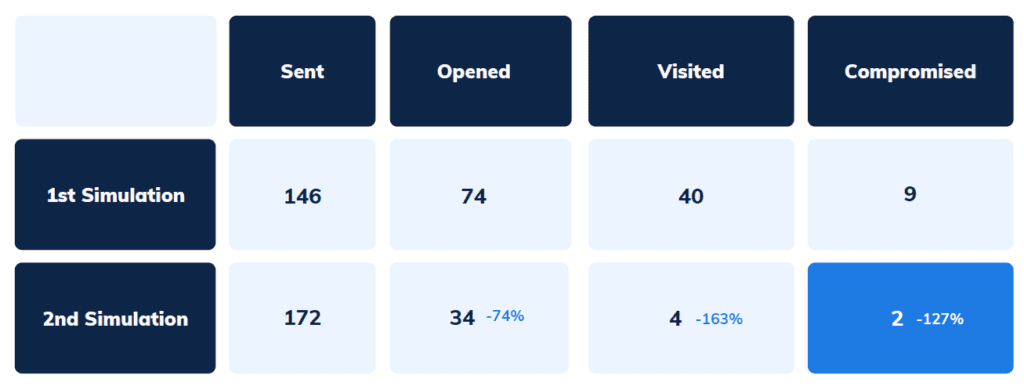

Identify which employees are at high risk of being compromised in a phishing attack.
Obtain an ongoing view of which employees are vulnerable to phishing attacks.
Deliver regular security awareness training that will help drive user resilience to phishing attacks, as well as improve general security behaviour.
Demonstrate compliance with ISO 27001 Clause 7.2.2.
Construction
200 employees
August 2020
A member of staff was compromised in a ‘Gift Card’ phishing attack.
Current security awareness training materials are unengaging and ineffective.
Current security awareness training approach is too time-consuming
Analyse each users’ current security strengths and weaknesses using a Gap Analysis Quiz.
Using the results of the quiz, each employee will receive a new security awareness course every four weeks, with courses being prioritised to address their weakest areas first.
Custom compliance courses will also be delivered periodically.
At least one phishing simulation will be launched every six months, in order to test the impact of the training and to identify any high-risk users.
Instant follow-up training will be deployed to any employees who compromise their credentials during a phishing simulation, in order to reduce risk as soon as possible.
Ongoing dark web monitoring will take place in order to identify and avoid early-stage attacks that leverage stolen employee credentials, like compromised usernames and passwords.
In order to measure the impact of the customer’s Human Risk Management program, key risk metrics were taken both at the very start of the program and after seven months of activity.
Below, you’ll see the ‘company’ risk score (all risk metrics fused together), a ‘training’ risk score, (a combination of course grades and course completion percentages), a ‘phishing’ risk score (the collated opened, clicked and compromised rates during phishing simulations) and a ‘dark web’ risk score (based on how much of your business’s sensitive data is exposed on the dark web).
Having conducted seven months of security awareness training, periodic simulated
phishing exercises and dark web breach scanning, the customer’s overall human risk score
was reduced by 152 points – moving them from ‘Medium’ risk to ‘Low’ risk.
The phishing risk within the business drastically decreased by 100 points, meaning that the employees were considerably better at spotting, avoiding and reporting suspected attacks.


In order to reduce human cyber risk, it was important to ensure that employees were completing their security awareness courses as soon as possible and reaching the minimum pass score of 80% in their follow-up questionnaires.
To ensure this happened, the completion rate and course grades were tracked for every employee, with automatic course reminder emails being sent out to any staff members who hadn’t completed their course within a few working days.
The ongoing phishing simulation results were also tracked to ensure that the security awareness training courses were having the desired impact.



Out of the 250 staff, 97% per cent started and completed their courses, taking on average just three days to finish their course after enrolment, whilst scoring, on average, 92%.
As seen in the Phishing Simulation Performance table, employees were much less likely to open, click or become compromised by a phishing simulation.
© IT.ie. All rights reserved. Designed and published by IT.ie.
We and our partners use cookies and process personal data (like unique IDs and Browse behaviour) to improve your experience, personalize content and ads, measure performance, and understand our audience.
You have the right to choose which cookies you'd like to enable. By clicking "Accept", you consent to all cookies. You can also "Reject" non-essential cookies, or manage your preferences through "View Preferences" below.
For more information on how we use cookies and your data, please read our Cookie Policy and Privacy Policy.
Fill in your details below and hit download.